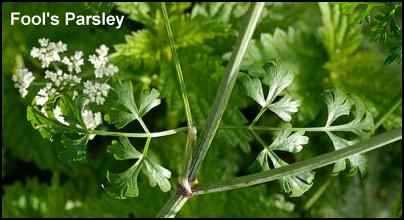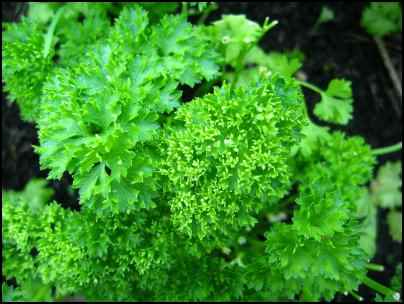Don’t despise parsley, that sprig of green that usually sits as a decoration on your dinner plate. It has much more going for it besides just looking pretty. Petroselinum hortense originated along the Mediterranean and has been used as a culinary herb for thousands of years. First cultivated in England in 1548, parsley originated on the island of Sardinia. It has since become completely naturalized in various parts of England and Scotland. Gerard declared it delightful to the taste and agreeable to the stomach.
The herb is said to have been dedicated to Persephone and to funeral rites by the Greeks. Ancient Greeks used parsley to form funeral wreaths and when profusely planted, became a green velvety carpet over the mounds of newly-dug graves. Garlands of it were used by the Greeks to crown their heroes. Greek lovers made wreaths to present to their beloved ones as expressions of true affection.
Romans also used garlands to crown their victorious athletes. They prized the herb highly for its aromatic flavor in sauces and other foods. Sumptuous parsley garlands were used to decorate the banquet tables of the Romans to absorb the fumes of too much imbibing. The word parsley is derived from the Greek word “petroselinin” which means “stone breaker”. Petroselinin became corrupted into Petrocilium – then anglicized into Peterslylinge, Persele, Persely and finally, Parsley. The Swiss call it “petersil”.
The leaves of the curly French parsley variety (Petroselinum Crispum) have a high chlorophyll content and are very effective at removing traces of onion and garlic odors—the original breath freshener! A reliable and indispensable herb in the kitchen, parsley has an impressive repertoire of culinary uses. Parsley is found to be a source of calcium, thiamin, vitamin B1, riboflavin, vitamin B2, niacin and vitamin C, besides being a rich source of iron. A poultice of the leaves is said to be an efficacious remedy for the bites and stings of poisonous insects. The bruised leaves, applied externally, have been used to dispel tumors suspected to be of a cancerous nature. Distilled water of parsley was formerly given to children troubled with wind, as dill water still is.
Country folks have long taken parsley tea for bladder troubles; the turnip-rooted variety is used medicinally by certain pharmaceutical houses in the preparation of mild laxatives. A fluid extract is made from both root and seeds. The extract made from the root acts more readily on the kidneys than that from other parts of the herb. Parsley root is faintly aromatic and has a sweetish taste. It contains starch, mucilage, sugar, volatile oil and Apian. It was said that the addition of powdered parsley in wine would purify the blood, stimulate the brain and improve memory! Parsley is also munched to provide serenity and a good appetite. There’s a reason it’s become a regular decorative item to our dinner plates.
There are two well-known varieties: the French double-curled (Petroselinum hortense var. crispum) is also known as moss-leaved. Its blossoms are either white or greenish-white and resemble Queen Anne’s lace. The fern-leaved variety (Petroselinum hortense var. filicinum) may grow as high as ten to twelve inches and withstands the winter cold far better than the curly varieties. Another lesser-known variety is the Hamburg or turnip-rooted parsley. This herb is considered a vegetable which is cultivated for its large root that resembles a small parsnip and when cooked has a flavor equally as sweet as celery and very similar in taste.

Beware of Fool’s Parsley (Anthriscus cynapium), a noxious weed of a poisonous nature that infests gardens and fields. The leaves are similar to plain-leaved parsley though a darker shade of green and when crushed emits an unpleasant odor. The most prominent difference is in the blossoms.
A biennial, parsley produces its lush growth in the first year and blossoms during the second growing season. To prevent the herb from going to seed, the delicate blossoms should be cut off as soon as they appear. To keep parsley productive, frequently cut back the full length of the outside stems and remove all flower stalks. These can be recognized by their thickness and sparse, coarse leaves. Once the plant has flowered, it is spent and will wither.
Propagate parsley by seed in the spring and where winters are mild, in the autumn also. These seeds are slow and erratic germinators; it is advisable to keep the bed well watered especially while seeds are germinating which can take as long as a month. Soaking the seeds in warm water for twenty-four hours before planting helps to speed up the sprouting process. Seed can be sown as early as February in my part of the country, but most are sown in April although a mid-August planting will give you a fresh winter crop. After it reaches the seedling stage, it does not respond well to any root disturbance.
Parsley, any of the varieties, is considered an aid to the growth of tomatoes and roses. Practitioners of companion planting keep parsley around their asparagus to repel the asparagus beetles. Sometimes you will lose plants to crown rot but its most serious threat is the larvae of the anise swallowtail butterfly. A large, handsome lime-green caterpillar with black and cream-colored stripes, it can quickly strip a plant of all its leaves to satisfy its voracious appetite. Pick this pest off by hand or treat with bacillus thuringiensis.
The moss-curled variety makes an attractive border when plants are set about eight inches apart. It creates low growing, neat mounds that are decorative as well as useful. This French variety is most popular because of the interesting foliage. Leaves are a deep green, finely divided and curled; when crushed, the leaves emit a pleasant celery-like scent. This variety also makes a good container plant.

Italian or Genovese parsley (P. Crispum neopolitanum) is a much tall-growing, bushier type with flat, green leaves that are deeply indented at the edges. This variety is sometimes brown for the use of its leafstalks, which are blanched and eaten like those of celery. Its leaves have a sweet and earthy flavor. Sometimes reaching a height of eighteen inches and spreading just as widely, give Italian parsley lots of growing space. This variety with its mild, peppery bite is favored by cooks because it imparts more flavor and Vitamin C.
The leaves contain organic iron and several vitamins; pick the outer leaves as you have need of them. In fact, plants will thrive if you give them a “haircut” about twice a month from May until frost. Harvest the leaves before the plant blooms. The leaves develop a bitter taste after flower stalks form. Keep fresh-cut parsley crisp and fresh by standing its stems in water; there is no need to refrigerate. To dry parsley for future use, cut the tender parts of the stems and leaves from the plants and place on screens in a shady, dry, well-ventilated location. When thoroughly dry, they may be crushed and stored in small, tightly-covered containers. In humid weather, an overnight stay in the oven with just the pilot light (leave the door ajar) will do an excellent job. How to freeze? Just wash, dry, wrap in plastic wrap or drop into a Ziploc baggie. Pop into your freezer, ready for cooking use.
Do use parsley copiously. It is an important part of the Middle Eastern tabbouleh. Burgundians in France feature parsley with ham in aspic. The Swiss are fond of fondue with deep-fried parsley on the side. The Mexicans and Spaniards use it as the prime ingredient in salsa verde and the English make parsley jelly.
The flavor, which is not distinctly pungent, makes it an excellent herb to use with others, giving depth to a blend. Snip parsley into white sauce, scrambled eggs, baked corn or potatoes. Add to biscuit mix and sprinkle upon a chicken pie filling before covering with crust. Fines Herbes is a combination of equal portions of parsley, chervil, thyme, and tarragon. This blend complements almost any meat or vegetable dish. Parsley is also an ingredient of the bouquet garni along with a bay leaf and a sprig each of thyme and marjoram. Keep its peppery flavor in mind to give a dish that essential fresh and alive taste and texture. Parsley flakes are very popular because they can be used so freely for a variety of dishes. Add them toward the end of the cooking period. Give the flakes a few minutes to soak in salad dressings, dips, sandwich spreads, et cetera, to release its flavor.
Try fresh parsley for vegetable soups, green salads, and even fruit salads. Even the stalks can be dried and pulverized in a food processor; keep the parsley powder handy to shake into any dish simmering on the stovetop. Parsley butter is good with almost any grilled meats or with baked potatoes. Have you tried making parsley jelly as the English do? Make it with a commercial pectin, following package directions and using parsley tea for the liquid. For a refreshing cup of tea, pour one pint of boiling water over a cupful of fresh parsley leaves. Let it steep for six minutes, strain and drink or use. Parsley jelly goes great with meat, poultry, and fish. Vinegars can also be made using either a combination of parsley and fennel or parsley and peppercorns. Delightful!
Parsley Growing Tips
Parsley is best grown from seed in the fall or very early spring. Compost mulch your plants especially during the winter and summer. Fertilize lightly with fish emulsion or manure. Soil must be rich, moist, and well-draining, and the seeds must not be allowed to dry out. Parsley’s taproot makes it difficult to transplant so sow seeds where you want the plants to grow. Plant hardy to zone 9, parsley will survive hot afternoon sun if given some shelter. Both varieties of parsley can be grown in sun or part-shade. Curly parsley attains about ten inches in height; Italian parsley grows to one-and-a-half feet tall and just as wide.
Facts about Parsley
- An old saying warns parsley must go to the devil and back seven times before germinating.
- Corpses were sprinkled with parsley to deodorize them.
- Growing wild from Sardinia east to Lebanon, parsley is cultivated throughout the temperate zone.
- The French variety of parsley does well grown on a windowsill.
- Parsley works well with most foods except sweets.
- An old folktale states: “if parsley is thrown into fish-ponds it will heal the sick fishes.”


